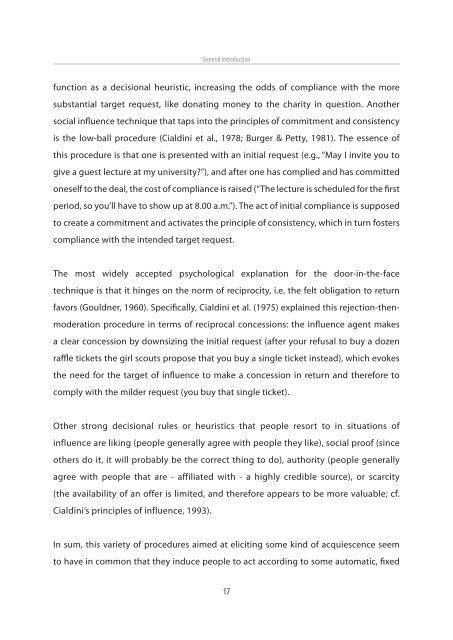Chapter 1 - Universiteit Twente
Chapter 1 - Universiteit Twente
Chapter 1 - Universiteit Twente
Create successful ePaper yourself
Turn your PDF publications into a flip-book with our unique Google optimized e-Paper software.
General Introduction<br />
function as a decisional heuristic, increasing the odds of compliance with the more<br />
substantial target request, like donating money to the charity in question. Another<br />
social influence technique that taps into the principles of commitment and consistency<br />
is the low-ball procedure (Cialdini et al., 1978; Burger & Petty, 1981). The essence of<br />
this procedure is that one is presented with an initial request (e.g., “May I invite you to<br />
give a guest lecture at my university?”), and after one has complied and has committed<br />
oneself to the deal, the cost of compliance is raised (“The lecture is scheduled for the first<br />
period, so you’ll have to show up at 8.00 a.m.”). The act of initial compliance is supposed<br />
to create a commitment and activates the principle of consistency, which in turn fosters<br />
compliance with the intended target request.<br />
The most widely accepted psychological explanation for the door-in-the-face<br />
technique is that it hinges on the norm of reciprocity, i.e. the felt obligation to return<br />
favors (Gouldner, 1960). Specifically, Cialdini et al. (1975) explained this rejection-thenmoderation<br />
procedure in terms of reciprocal concessions: the influence agent makes<br />
a clear concession by downsizing the initial request (after your refusal to buy a dozen<br />
raffle tickets the girl scouts propose that you buy a single ticket instead), which evokes<br />
the need for the target of influence to make a concession in return and therefore to<br />
comply with the milder request (you buy that single ticket).<br />
Other strong decisional rules or heuristics that people resort to in situations of<br />
influence are liking (people generally agree with people they like), social proof (since<br />
others do it, it will probably be the correct thing to do), authority (people generally<br />
agree with people that are - affiliated with - a highly credible source), or scarcity<br />
(the availability of an offer is limited, and therefore appears to be more valuable; cf.<br />
Cialdini’s principles of influence, 1993).<br />
In sum, this variety of procedures aimed at eliciting some kind of acquiescence seem<br />
to have in common that they induce people to act according to some automatic, fixed<br />
17
















